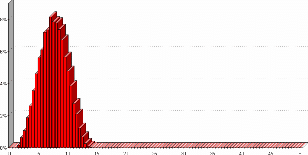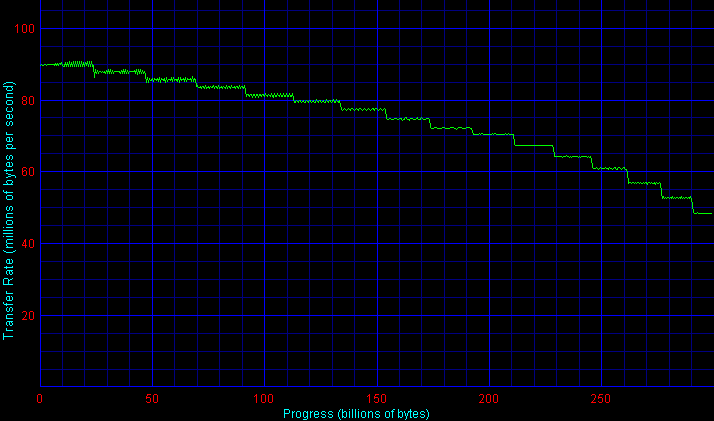Note: Since the publication of this review, this drive has been retested under Testbed4, a newer hardware/software/benchmark platform. Please see this article for updated results. This review remains for reference purposes only.
|

As one of a new breed of SCSI drives, the Atlas 10K V crams 73-gigabytes of data onto a single two-sided platter that measures less than three inches in diameter. Par for the course, Maxtor’s flagship remains a four-platter design and yields a maximum capacity of 300 GB in a low-profile chassis. The Atlas continues a trend of differentiating seek times between family members with varying platter counts. While the single-platter 8D073x0 model scores a 4.0 ms claim, the 300 GB flagship comes stamped with a slightly more sedate 4.4 ms seek time. Although ATA drives (including Maxtor’s own MaXLine III) have started the scramble to a roomier 16 MB buffer, the 10K V remains at an industry-standard eight megabytes.
With the 10K V, the firm has moved the Atlas to fluid dynamic bearing motors and has introduced a host of secondary improvements intended to maintain or increase performance. Maxtor positions the Atlas 10K V to service traditional workhorse server applications where capacity and cost constraints rule out high-speed 15,000 RPM drives. A standard five-year warranty backs the drive.
Delivering best-of-class single-user and server performance, the Atlas 10K IV has enjoyed StorageReview’s 10K RPM Leaderboard slot for nearly two years now. Let’s see how high Maxtor sets the bar with the 10K V. In the following tests, the 300 GB Maxtor Atlas 10K V is compared against the following drives for the following reasons:
| Maxtor Atlas 10K IV (147GB) | Predecessor of the review unit |
| Fujitsu MAP3147 (147 GB) | Previous-generation competitor |
| Hitachi/IBM Ultrastar 146Z10 (147 GB) | Previous-generation competitor |
| Seagate Cheetah 10K.6 (147 GB) | Previous-generation competitor |
| Western Digital Raptor WD740GD (74 GB) with TCQ enabled | Enterprise-oriented 10K RPM SATA drive |
Low-Level ResultsFor diagnostic purposes only, StorageReview measures the following low-level parameters: Average Read Access Time– An average of 25,000 random accesses of a single sector each conducted through IPEAK SPT’s AnalyzeDisk suite. The high sample size permits a much more accurate reading than most typical benchmarks deliver and provides an excellent figure with which one may contrast the claimed access time (claimed seek time + the drive spindle speed’s average rotational latency) provided by manufacturers. WB99 Disk/Read Transfer Rate – Begin– The sequential transfer rate attained by the outermost zones in the hard disk. The figure typically represents the highest sustained transfer rate a drive delivers. WB99 Disk/Read Transfer Rate – End– The sequential transfer rate attained by the innermost zones in the hard disk. The figure typically represents the lowest sustained transfer rate a drive delivers. |
For more information, please click here.
|
Note: Scores on top are better. |
|
||||||||||||||||||||
|
8D300L0 Average Read Service Time |
|||||||||||||||||||
|---|---|---|---|---|---|---|---|---|---|---|---|---|---|---|---|---|---|---|---|---|
AnalyzeDisk pegs the Atlas 10K V’s average access time at 7.6 milliseconds, a figure that matches the score delivered by the drive’s predecessor. Accounting for the average rotational latency of a 10,000 RPM drive (3 ms) leads to a measured average seek time of 4.6 milliseconds. Maxtor claims a 4.4 ms seek time for the flagship 300 GB model- the Atlas misses its spec by about 0.2 ms. Even so, the 10K V joins its predecessor in posting the fastest recorded access time for a 10,000 RPM drive.
|
Note: Scores on top are better. |
|
|||||||||||||||||||||||||||||||||||||||
|
|
||||||||||||||||||||||||||||||||||||||
8D300L0 Transfer Rate |
|||||||||||||||||||||||||||||||||||||||
The Atlas shatters previously-set records when it comes to transfer rates. Outer-zone tests yield sustained throughput of 89.5 MB/sec and allow the Atlas to leapfrog marks set by last-generation 15K RPM units (not shown, but, as always, readers may create their own custom comparisons with the StorageReview Drive Performance Database). Meanwhile, Maxtor’s inner-zone score of 52.1 MB/sec easily tops the SCSI competition; interestingly enough, however, the Atlas lags behind the SATA Raptor, a drive featuring just one-half the areal density of Maxtor’s monster.
Single-User PerformanceStorageReview uses the following tests to assess non-server use: StorageReview.com Office DriveMark 2002– A capture of 30 minutes of actual computer productivity use that exactingly recreates a typical office-style multitasking environment. The applications include: Outlook XP, Word XP, Excel XP, PowerPoint XP, Calypso (a freeware e-mail client), SecureCRT v3.3 (a telnet/SSH client), CuteFTP Pro v1.0 (an FTP/SSH client), ICQ 2000b), Palm Hotsync 4.0, Gravity 2.3 (a Usenet/newsgroups client), PaintShop Pro v7.0, Media Player v8 for the occasional MP3, and Internet Explorer 6.0. StorageReview.com High-End DriveMark 2002– A capture of VeriTest’s Content Creation Winstone 2001 suite. Applications include Adobe Photoshop v5.5, Adobe Premiere v5.1, Macromedia Director v8.0, Macromedia Dreamweaver v3.0, Netscape Navigator v4.73, and Sonic Foundry Sound Forge v4.5. Unlike typical productivity applications, high-end audio- and video- editing programs are run in a more serial and less multitasked manner. The High-End DriveMark includes significantly more sequential transfers and write (as opposed to read) operations. |
StorageReview.com Bootup DriveMark 2002– A capture of the rather unusual Windows XP bootup process. Windows XP’s boot procedure involves significantly different access patterns and queue depths than those found in other disk accesses. This test recreates Windows XP’s bootup from the initial bootstrap load all the way to initialization and loading of the following memory-resident utilities: Dimension4 (a time synchronizer), Norton Antivirus 2002 AutoProtect, Palm Hotsync v4.0, and ICQ 2000b.
StorageReview.com Gaming DriveMark 2002– A weighted average of the disk accesses featured in five popular PC games: Lionhead’s Black & White v1.1, Valve’s Half-Life: Counterstrike v1.3, Blizzard’s Diablo 2: Lord of Destruction v1.09b, Maxis’s The Sims: House Party v1.0, and Epic’s Unreal Tournament v4.36. Games, of course, are not multitasked- all five titles were run in a serial fashion featuring approximately half an hour of play time per game.
For more information, please click here.
|
Note: Scores on top are better. |
With a score of 613 I/Os per second, the Atlas 10K V tops the competition in the SR Office DriveMark, a test that replicates actual productivity use. The 10K V betters the previous SCSI record-holder (Maxtor’s own Atlas 10K IV) by nearly 22%.
The 10K V muscles its way ahead of the competition in the SR High-End DriveMark, a suite that replicates the use of content-creation applications that create large files and hence features more sequential transfers and more write operations than the Office DriveMark. At 585 I/Os per second, the Atlas again bests its predecessor by a margin of over 26%.
SR’s Bootup DriveMark replicates the Windows XP bootup process, a mix of operations that tends to creates queue depths not usually seem in a non-server environment. Here the Atlas 10K V again tops the charts, leaving the Raptor WD740GD behind by a margin of 16%.
Finally, Maxtor’s contender tops the charts in the SR Gaming DriveMark, a weighted average of five popular PC entertainment titles. The 10K V tops the IV by a margin of 17% and leaves all other units trailing by even larger margins.
Multi-User PerformanceStorageReview uses the following tests to assess server performance: StorageReview.com File Server DriveMark 2002– A mix of synthetically-created reads and writes through IOMeter that attempts to model the heavily random access that a dedicated file server experiences. Individual tests are run under loads with 1 I/O, 4 I/Os, 16 I/Os, and 64 I/Os outstanding. The Server DriveMark is a convenient at-a-glance figure derived from the weighted average of results obtained from the four different loads. StorageReview.com Web Server DriveMark 2002– A mix of synthetically-created reads through IOMeter that attempts to model the heavily random access that a dedicated web server experiences. Individual tests are run under loads with 1 I/O, 4 I/Os, 16 I/Os, and 64 I/Os outstanding. The Server DriveMark is a convenient at-a-glance figure derived from the weighted average of results obtained from the four different loads. For more information click here. |
|
Note: Scores on top are better. |
|
|||||||||||||||||||||||||||||||||||||||
|
|
||||||||||||||||||||||||||||||||||||||
Though great single-user performance is certainly nothing to sneeze at, the server market remains a 10K RPM SCSI drive’s raison d’etre. Non-localized access and high queue depths differentiate server-style disk access from even the most demanding of workstation loads.
When it comes to the SR File Server DriveMark, a mix of random reads and writes featuring varying block sizes, the Atlas 10K V manages an incremental improvement over the 10K IV by posting a weighted score of 275 I/Os per second and records the highest mark yet seen from a 10,000 RPM drive. Offerings from Fujitsu and Seagate lag by about 7% while the SATA Raptor, even when paired with the TCQ-enabled Promise FastTrak TX4200, brings up the rear.
In the Web Server DriveMark, a mix that features only read accesses, the 10K V and IV tie for the top of the chart at 261 I/Os per second. The competition trails here too, albeit by a narrower spread than that of the File Server test.
Legacy PerformanceeTesting Lab’s WinBench 99 Disk WinMark tests are benchmarks that attempt to measure desktop performance through a rather dated recording of high-level applications. Despite their age, the Disk WinMarks are somewhat of an industry standard. The following results serve only as a reference; SR does not factor them into final judgments and recommends that readers do the same. |
|
Note: Scores on top are better. |
|
|||||||||||||||||||||||||||||||||||||||
|
|
||||||||||||||||||||||||||||||||||||||
Despite the move to FDB motors, the Atlas 10K V yields an objective idle noise measurement of 48.8 dB/A- quite high in this day and age. That said, this specific comparison of 10K RPM drives once again reminds us that objective measurements often do not reveal the whole story when it comes to acoustics. The Ultrastar 146Z10, objectively speaking, leads the SCSI pack at just 45.9 dB/A. Subjectively, however, the Ultrastar is considerably more obtrusive than the 10K V and the Cheetah 10K.6. In the end, when installed in our testbed chassis, the Atlas at idle remains relatively quiet despite its high measurement. Seeks, as one would expect, are rather audible given the Maxtor’s aggressive random access times. The Atlas 10K V weighs in at 29.9 degrees Celsius above ambient room temperature after operating under an extended heavy load. As a server-oriented SCSI drive, the Atlas is not intended for installation in a cramped ATX case. Care must be taken to integrate the disk in an environment with steady, free airflow.
According to filtered and analyzed data collected from participating StorageReview.com readers, a predecessor of the Note that the percentages in bold above may change as more information continues to be collected and analyzed. For more information, to input your experience with these and/or other drives, and to view comprehensive results, please visit the SR Drive Reliability Survey.
Our only caveat is the drive’s cost- a quick check at the time of this writing on the single-platter 73 GB model reveals that the Atlas 10K V commands a price nearly 75% higher than that of the 10K IV! Hopefully as production ramps up, as the competition arrives, and as the 10K IV clears out of the channel we’ll see this all-around blazing performer’s price move more into line.
|
||||||||||||||||||||||||||||||||||||||||||||||||




 Amazon
Amazon